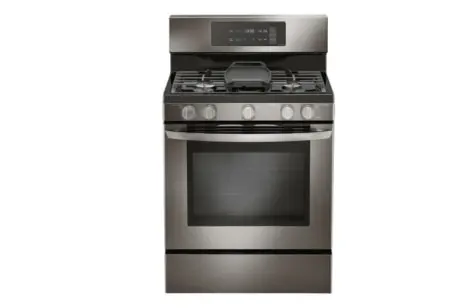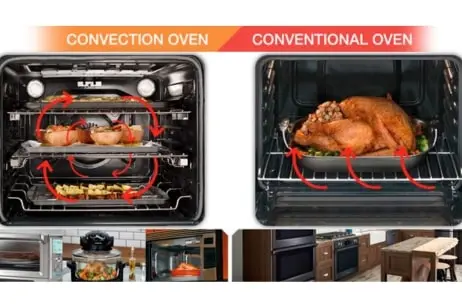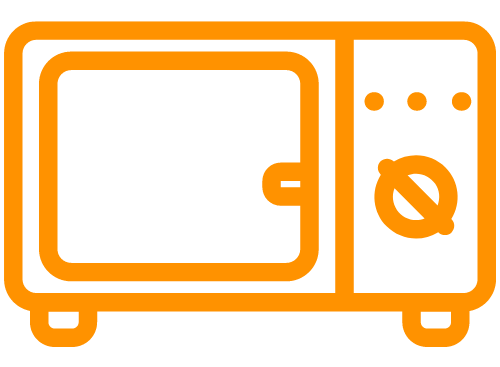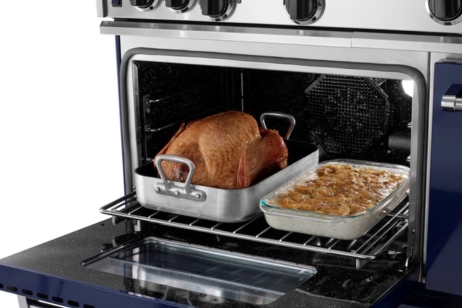Welcome to our guide all about static ovens! If you’ve ever wondered how static ovens work and what makes static ovens special, you’re in the right place. Static ovens are cool kitchen appliances that use heat to cook our food as we like it. This article will explore everything you need to know about static ovens. So, get ready to discover the secrets behind these amazing cooking machines!
Table of Contents
ToggleWhat is a Static Oven?
Static Oven, also known as a Conventional Oven. A static oven is a kitchen appliance commonly used for baking, roasting, and heating food. It is a fundamental and widely available type of oven found in households and commercial kitchens.
The term “static” refers to how heat is distributed within the oven during cooking. In a static oven, heat radiates from heating elements at the top and bottom of the cavity. These heating elements generate and maintain a consistent temperature inside the oven, allowing food to cook evenly.
Static ovens come in various sizes and designs, but their basic functionality remains. They typically consist of a control panel to set the desired temperature and cooking mode, a heating system, and an insulated cavity to contain the heat.

How Does a Static Oven Work?
A static oven, or a conventional oven, operates based on a simple yet effective mechanism. Understanding how a static oven works can help you make the most of this kitchen appliance. Let’s dive into the working principle of a static oven:
10 Reasons Why Your Oven is Not Working and How to Fix?
1. Heating Elements:
A static oven contains heating elements positioned at the top and bottom of the oven cavity. These elements are responsible for generating heat.
2. Temperature Control:
The oven features a temperature control mechanism to set the desired cooking temperature. When you select a temperature, the heating elements generate heat.
3. Heat Distribution:
The heating elements emit heat once the oven is turned on. The heat rises from the bottom heating element and flows upwards, while simultaneously, the top heating element emits heat downwards. This process creates a convection-like effect within the oven cavity.
4. Radiant Heat:
As the heating elements generate heat, the oven cavity absorbs the energy. The oven’s walls, ceiling, and floor absorb the heat and become hot. This accumulated heat is then radiated throughout the oven cavity.
5. Cooking Process:
When you place food inside the oven, the hot air and radiant heat within the cavity start to cook the food. The heat penetrates the food, gradually raising its internal temperature and facilitating cooking. The even heat distribution ensures that the food cooks uniformly from all sides.
6. Temperature Regulation:
The oven’s temperature control mechanism continuously monitors the temperature inside the cavity. If the temperature deviates from the set value, the heating elements switch on or off to maintain a consistent temperature.
7. Timer and Controls:
Static ovens typically have a timer and control panel. These features allow you to set cooking durations and adjust settings such as preheating, baking modes, and temperature adjustments.
By understanding the workings of a static oven, you can use its features to cook a wide range of dishes. It’s important to follow the recommended cooking times and temperature settings. You can achieve optimal results for each recipe.
15 Convection Oven Recipes: From Appetizers to Desserts
Types of Static Ovens
There are different kinds of static ovens, which are also called conventional ovens. These ovens work in various ways to help you cook. Let’s explore some of the types:
1. Freestanding Static Oven:
This is a regular oven that you can place anywhere in your kitchen. It doesn’t need to be attached to anything else. Some freestanding ovens also have a cooking surface on top.
2. Built-in Static Oven:
These ovens are made to fit right into your kitchen cabinets or walls. They blend in nicely with your kitchen’s look and style. Built-in ovens come in different sizes to fit different kitchens.
3. Double Static Oven:
A double static oven is like having two ovens stacked on each other. You can cook different dishes at the same time using different temperatures. This is useful when you need to make a lot of food or have guests over.
4. Compact Static Oven:
Compact ovens are smaller, perfect for kitchens with limited space, like apartments or small homes. Even though they’re smaller, they can still do the job of cooking food.
5. Retro-style Static Oven:
These ovens have a cool vintage look, like something from the past. They combine old-fashioned style with modern cooking features to make your kitchen unique.
6. Pyrolytic Static Oven:
Pyrolytic ovens can clean themselves! They get hot, which turns any leftover food into ash. Then, you have to wipe away the ash, and your oven is clean again. It’s a handy feature that saves you time and effort.
7. Multi-function Static Oven:
These ovens can do more than bake and roast. They have different settings for grilling, defrosting, and using a fan to help cook your food. With a multi-function oven, you have more options for cooking different dishes.
When choosing an oven, consider what you need it for, how much space you have, and what features are important to you. Each type of oven has its benefits, so pick the one that fits your needs and makes cooking enjoyable.
Uses of Static Ovens
Static ovens have many different uses that can make cooking easier and more enjoyable. Let’s explore some of the things you can do with a static oven:
1. Baking
Static ovens are great for baking yummy treats like cakes, cookies, and bread. The oven’s heat ensures that everything bakes evenly and tastes delicious.
2. Roasting
A static oven is perfect for cooking meat or vegetables with a nice crispy outside. It uses heat from the top and bottom to make the food turn golden brown and juicy.
3. Making Casseroles and Cheesy Dishes
Making casseroles and cheesy dishes: Static ovens are helpful when making casseroles or ones with melted cheese. The heat spreads evenly, so everything gets cooked just right.
4. Slow cooking
Some recipes must cook for a long time to get tender and flavorful. Static ovens are great for that. They can cook food slowly at a low temperature, making it super tasty.
5. Sterilizing and drying
Some static ovens have special settings that let you sterilize things like canning jars or dry fruits, vegetables, or herbs. This is useful for preserving food or making healthy snacks.
Static ovens are versatile and can make cooking lots of different foods easier. Whether baking sweet treats, roasting savory dishes, or even drying fruits, a static oven can help you make delicious meals; always remember to be safe and follow the instructions.
Tips for Using a Static Oven Effectively
Using a static oven effectively can enhance your cooking experience and ensure delicious results. Here are some helpful tips to make the most of your static oven:
Tip 1: Get the Oven ready:
Before you start cooking, let the oven warm up by turning it on and waiting for it to reach the right temperature. This helps make sure your food cooks evenly.
Tip 2: Put things in the right place:
Different foods need to be on different shelves in the oven. Most of the time, you should put your food on the middle shelf. But if you want it to get browner on top, you can put it on the top shelf. Just make sure to adjust the shelves to fit your food.
Tip 3: Don’t crowd the oven:
If you’re cooking more than one thing, don’t pack them too close together in the oven. Give them space so the heat can go around and cook everything evenly. Use more than one shelf or put things in different spots if needed.
Tip 4: Check the temperature:
Sometimes the oven might not be the right temperature, even if you set it that way. To be sure, you can use a special thermometer made for ovens. It tells you the actual temperature so that you can adjust it.
Tip 5: Turn and flip your food:
When cooking something, turning it around halfway through is a good idea. This helps it cook evenly on all sides. If you’re cooking vegetables or meat that need to be browned on both sides, you can flip them over to get the right color.
Tip 6: Keep an eye on the time:
Pay attention to how long your recipe says to cook the food. But remember, sometimes things might cook faster or slower depending on your oven or how great the food is. Check your food regularly to ensure it’s not cooking too much or too little.
Tip 7: Keep your oven clean:
Make sure to clean your oven regularly to keep it working well. Get rid of any grease or leftover food. Follow the instructions from the oven’s maker for the best way to clean it.
Following these tips, you can use your oven well and make tasty food. Try out different recipes and see what you can create with your oven!
How to Buy a Static Oven?
Are you looking to buy a new static oven for your kitchen? This guide will help you understand how to buy a static oven without using complicated words or technical terms. Let’s get started!
Step 1: Know What You Need
Think about what you want in an oven. Consider how big it should be, how much food it can cook, and how much space you have in your kitchen. This will help you find an oven that fits your needs perfectly.
Step 2: Do Some Research
Look up different brands and models of static ovens. Check reviews from people who have bought them before. This will give you an idea of which ovens are good and reliable.
Step 3: Decide on a Budget
Figure out how much of a budget you have for a static oven. It’s important to choose one that fits your budget. Remember, a higher price doesn’t always mean better quality.
Step 4: Look at the Features
Think about the features you want in your oven. Do you want it to have different cooking modes? Adjustable shelves? Easy-to-use buttons? Consider what matters most to you.
Step 5: Visit the Store or Go Online
Go to a store that sells ovens or browse online to see the options available. Take a good look at the ovens and ask questions to the store staff if you need help. Online websites also provide lots of information and customer reviews.
Step 6: Compare Prices
Compare the prices of different ovens to find the best deal. Look for discounts or warranty offers that can save you money. Remember, it’s not just about the price but also the value you get for what you pay.
Step 7: Think About After-Sales Service
Consider what happens after you buy the oven. Check if a warranty, repair services, or spare parts are available. Choosing a brand that offers reliable support if you need help later is good.
Step 8: Make Your Purchase
Once you have researched, compared prices, and decided, it’s time to buy the oven. Make sure you understand the store’s return policy and pay securely.
Difference Between Static and Convection Ovens
Static ovens and convection ovens are two types of kitchen appliances that cook food differently.
A static oven, also called a conventional oven, uses top and bottom heating components. The heat spreads inside the oven, cooking food with hot air. It doesn’t have a fan to move the air around. This can sometimes uneven the heat, causing some parts of the food to cook more than others. Static ovens are easy to use and cheaper.
In contrast, convection ovens have a special fan. The fan blows the hot air around inside the oven. This makes the heat distribute more evenly, so the food cooks more evenly. Convection ovens can cook food faster because the hot air moves around more. They’re great for baking and cooking different dishes at the same time.
So, static ovens cook with radiant heat, while a fan moves about the heated air in convection ovens. Static ovens are simpler and cheaper, but convection ovens cook more evenly and faster because of the fan.

FAQs
Is a Static Oven a Fan Oven?
No, a static oven is not a fan oven. A static oven doesn’t have a fan to circulate heat like a fan oven.
What does a Static Oven do?
A static oven uses heat from the top and bottom elements to cook food. It doesn’t have a fan to distribute the heat evenly.
What is the symbol for a Static Oven?
The symbol for a static oven is usually a rectangle with lines at the top and bottom, representing the heating elements.
What is the difference between a Static and a Convection Oven?
The main difference between a static and a convection oven is that a convection oven has a fan to blow hot air around., which helps cook food more evenly and faster.
How do you bake in a Static Oven?
To bake in a static oven, place your food on a baking tray or oven rack and set the temperature according to your recipe. The heat from the top and bottom elements will cook the food.
What is the difference between Ventilated and static Oven?
A ventilated oven has a fan that circulates hot air, while a static oven doesn’t. The fan in a ventilated oven helps distribute heat evenly, resulting in more even cooking.
What is a Gas Static Oven?
A gas static oven uses gas as the fuel source to generate heat for cooking. It works similarly to a regular static oven but with gas instead of electricity.
What is a Static Electric Oven?
A static electric oven uses electricity as the power source to generate heat for cooking. It doesn’t have a fan, so heat comes from the top and bottom elements to cook the food.
Read More
How to Clean Burnt Sugar from Oven: Learn 11 Easy Methods


